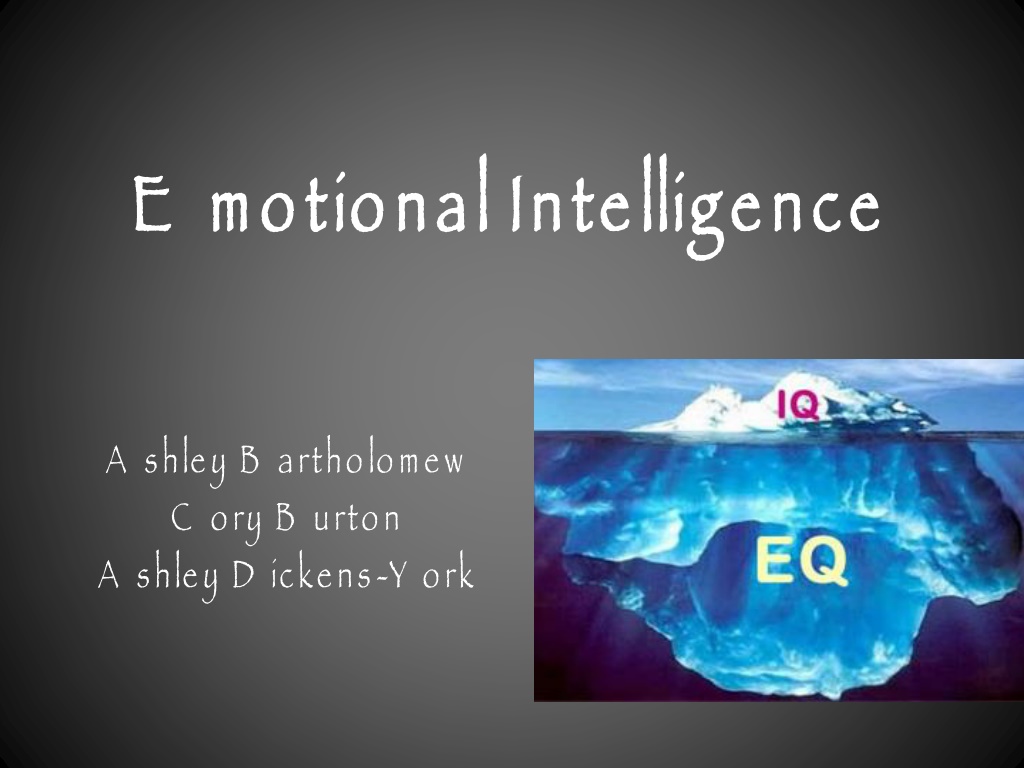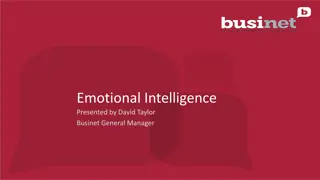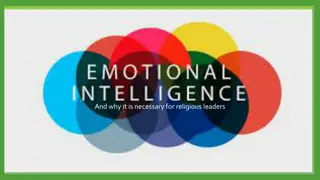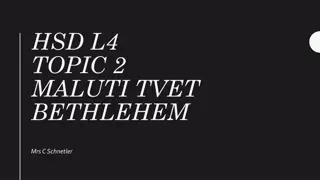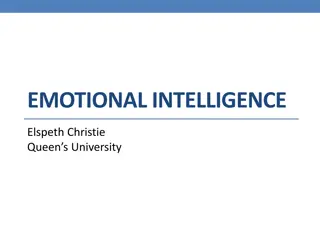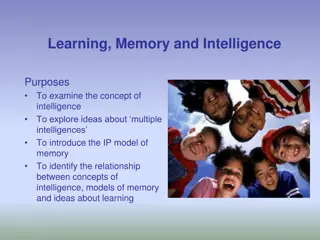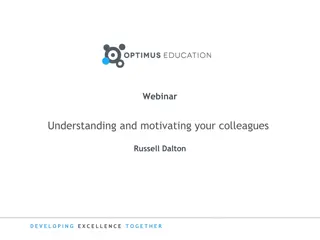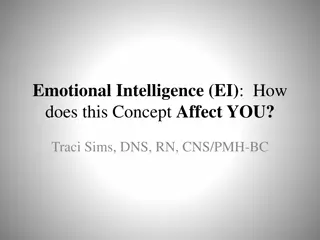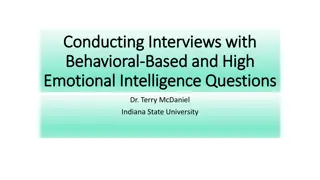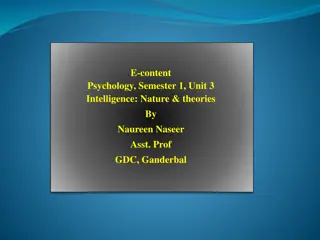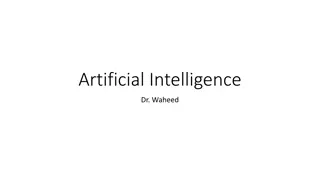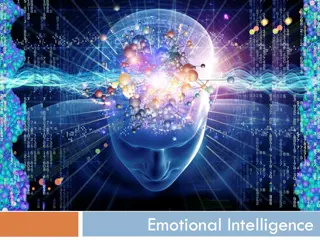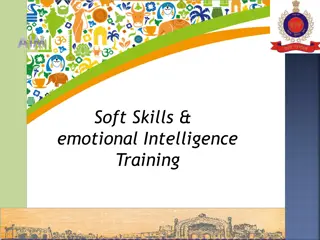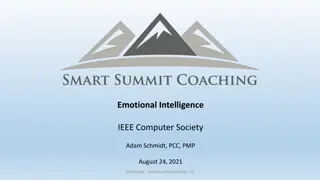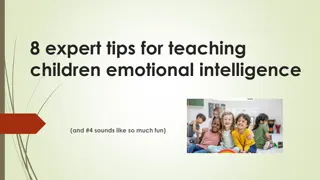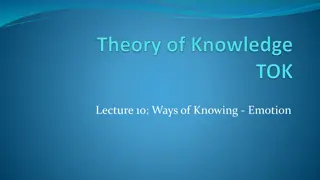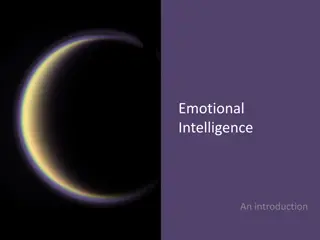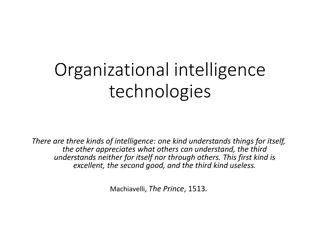Understanding Emotional Intelligence: Origins and Models
Emotional Intelligence (EI) revolves around perceiving, understanding, and managing emotions effectively. Originating from Darwin to modern scholars like Daniel Goleman, EI has evolved through various models such as Ability-Based EI, Trait EI, and Mixed Models. The concept gained popularity with Goleman's book, emphasizing its significance beyond IQ. Different scholars have contributed to shaping the understanding of EI as a crucial aspect of human behavior and interaction.
Download Presentation

Please find below an Image/Link to download the presentation.
The content on the website is provided AS IS for your information and personal use only. It may not be sold, licensed, or shared on other websites without obtaining consent from the author. Download presentation by click this link. If you encounter any issues during the download, it is possible that the publisher has removed the file from their server.
E N D
Presentation Transcript
E motional Intelligence E motional Intelligence A shley B artholomew C ory B urton A shley D ickens-Y ork
O verview of E motional Intelligence B rief H istory E I M odels/ M easurement A bility B ased M odel T rait E I M odel M ixed M odels P roblems/ C riticisms of E I E I in the W orkplace
O rigins of the C oncept D arwin s early work on the importance of emotional expression for survival (1 8 7 0s) E .L . T horndike (1 9 2 0) used the term social intelligence to describe the skill of understanding and managing other people **
O rigins of the C oncept D avid W echsler (1 9 40) described the influence of non-intellectual factors on intelligent behavior A rgued that models of intelligence won t be complete until they adequately describe these factors **
O rigins of the C oncept H oward G ardner (1 9 8 3 ) introduced the ideal of multiple intelligences Interpersonal intelligence: the capacity to understand the intentions, motivations, and desires of other people Intrapersonal intelligence: the capacity to understand oneself, to appreciate one s feelings, fears, and motivations **
O rigins of the C oncept T he term E motional Intelligence finally became widely popular upon the publication of D aniel G oleman s best seller E motional Intelligence: W hy It C an M atter M ore T han IQ **
E motional Intelligence M odels M uch confusion regarding exact meaning of this construct D efined slightly differently by each model 3 main models of E I: A bility E I M odels T rait E I M odel M ixed M odels of E I
A bility B ased E I D eveloped by P eter S alovey and J ohn D . M ayer D efine E I: the ability to perceive emotion, integrate emotion to facilitate thought, understand emotions, and to regulate emotions to promote personal growth **
A bility B ased E I: A ssumptions E motional intelligence defined within the confines of the standard criteria for a new intelligence E motions are useful sources of info that help one to make sense of/ navigate their social environments **
A bility B ased E I: A ssumptions Individuals vary: In their ability to process information of an emotional nature In their ability to relate emotional processing to a wider cognition T hese abilities manifest in certain adaptive behaviors **
A bility B ased E I: A ssumptions E motional Intelligence A bilities: P erceiving E motions - ability to decipher emotions in faces, pictures, voices, and cultural artifacts U nderstanding E motions - ability to comprehend emotion language and to appreciate complicated relationships among emotions **
A bility B ased E I: A ssumptions E motional Intelligence A bilities: U sing E motions - ability to harness emotions to facilitate various cognitive activities, such as thinking and problem solving M anaging E motions - ability to regulate emotions in both ourselves and in others **
A bility B ased E I: M easurement M S C E IT : M ayer-S alovey-C aruso E motional Intelligence T est B ased on a series of emotion-based problem- solving items T ests individual s abilities on each of the four branches of emotional intelligence S cores generated for each of the four branches as well as a total score **
A bility B ased E I: M easurement M S C E IT : S coring Individual s responses compared to those provided by worldwide sample of respondents W ith higher scores indicating higher overlap between individual and comparison group E xpert-scored W here individual s score is compared to a group of 2 1 emotion researchers U nlike IQ test, items on M S C E IT do not have objectively correct responses D ifficult to regard as a genuine intelligence
A bility B ased E I: M easurement Issues M S C E IT may only measure knowledge, not ability: T hat is, even though someone may know how to behave in an emotional situation, he/ she may not be able to carry out behavior (B rody, 2 004) M S C E IT may only measure conformity (R oberts et al., 2 001 ) S elf-report measures are susceptible to social desirability bias
T rait E I M odel P roposed by P etrides et. al. (2 000) M ajor critics of ability based model and M S C E IT D efined T rait E I: a constellation of emotion-related self-perceptions located at the lower levels of personality B ased on individual s self-perceptions of their emotional abilities **
T rait E I: M easurement T E IQ ue: T rait E motional Intelligence Q uestionnaire S elf-report inventory 1 5 subscales organized under 4 factors: W ell-being S elf-control E motionality S ociability A long with scores for the subscales and main factors, a global trait E I score is also given **
T rait E I: T E IQ ue M easurement
T rait E I: F indings T E IQ ue: S cores have been found to be globally normally distributed and reliable S cores were not related to nonverbal reasoning P ossible support for the personality trait view R elated to B ig 5 : P ositively related E xtraversion, A greeableness, O penness, C onscientiousness Inversely related N euroticism **
M ixed M odels of E I: E motional C ompetencies D eveloped by D aniel G oleman D efine E I: a wide array of competencies and skills that drive leadership performance P eople are born with general emotional intelligence that determines their potential for learning emotional competencies T hese competencies are learned capabilities that must be worked on to achieve outstanding performance **
M ixed M odels of E I: E motional C ompetencies P ersonal C ompetence
M ixed M odels of E I: E motional C ompetencies S ocial C ompetence
E motional C ompetencies: M easurement T wo measurement tools for G oleman s model E C I: E motional C ompetency Inventory, 1 9 9 9 R evised; E S C I: E motional and S ocial C ompetency Inventory, 2 007 E motional Intelligence A ppraisal, 2 001 C an be self-report O r 3 6 0-degree assessment **
E motional C ompetencies: M easurement E C I E motional C ompetence Inventory A pproximately 40% of items came from an older instrument, the S elf-A ssessment Q uestionnaire D eveloped by B oyatzis, 1 9 9 4 T hese earlier items have been validated against performance in hundreds of competency studies of managers, executives, and leaders in N orth A merica, Italy, and B razil T here is no research that supports the validity of E C I
M ixed M odels of E I: B ar-O n M odel of E motional-S ocial Intelligence D eveloped by R euven B ar-O n 1stto use the term: E motion Q uotient D efine E I: being concerned with effectively understanding oneself and others, relating well to people, and adapting to and coping with the immediate surroundings to be more successful in dealing with environmental demands **
B ar-O n E I M odel: A ssumptions E motional intelligence develops over time C an be improved through training or therapy E motional intelligence and cognitive intelligence contribute equally to a person s general intelligence, which then indicates one s potential to succeed in life Individuals with higher than average E Q s are in general more successful in meeting environmental demands and pressures D eficiency in E Q can mean a lack of success and emotional problems **
B ar-O n M odel: M easurement E Q -I: B ar-O n E motion Q uotient Inventory 1 3 3 questions used to obtain a T otal E Q A lso gives 5 composite scale scores corresponding to the 5 main components of the model N ot meant to measure personality traits or cognitive capacity; rather the mental ability to be successful in dealing with environmental demands and pressures
B ar-O n M odel: M easurement Issues E Q -I S elf-report, highly susceptible to faking O riginally developed in a clinical setting, not the work environment M uch is known about its reliability and convergent and discriminate validity L ittle is known about its predictive ability in the work environment H owever, E Q -I was predictive of success for U .S . A ir F orce recruiters; by using the test, the A ir F orce saved 3 million dollars annually
Is E I a F orm of Intelligence? G oleman exemplifies more clearly than most the fundamental absurdity of the tendency to class almost any type of behavior as an intelligence If these five abilities define emotional intelligence , we would expect some evidence that they are highly correlated; G oleman admits that they might be quite uncorrelated, and in any case if we cannot measure them, how do we know they are related? S o the whole theory is built on quicksand: there is no sound scientific basis. E ysenck, 2 000
Is E I a F orm of Intelligence? L ocke (2 005 ) suggested that emotional intelligence is not a new or distinct form of intelligence; rather, it is simply the intelligence construct applied to the domain of emotions. H ence, it is more like a skill.
D oes E I H ave P redictive V alue? D avies, S tankov, & R oberts (1 9 9 8 ) concluded that there was nothing empirically new in the idea of emotional intelligence M easures utilized at that time were new, and little was known about their psychometric properties (C herniss, 2 000) L andy (2 005 ) stated that the few incremental validity studies conducted on E I have shown that it adds nothing of real value to prediction of academic and work success
E I M easurement Issues B usiness vs. A cademics the former often make grandiose predictions predicated upon emotional intelligence while the latter warns against unscientific abuses
E I M easurement Issues F or example: G oleman has asserted the most effective leaders are alike in one crucial way: they all have a high degree of what has come to be known as emotional intelligence E I is the sine qua non of leadership M ayer rebuts, the popular literature s implication-that highly emotionally intelligent people possess an unqualified advantage in life-appears overly enthusiastic at present and unsubstantiated by reasonable scientific standards
E I and G ender D ifferences W omen are higher than men: E mpathy S ocial R esponsibility M en are higher than women: S tress T olerance S elf C onfidence
E I in the W orkplace C ritics believe that improving literacy and analytical skills is the best way to improve job performance C ognitive skills will only get you in the door S teve S tein
E I in the W orkplace H ighly E motional Intelligent E mployees: L ower absenteeism B etter psychological health H igher commitment C learer role boundaries H igher job satisfaction B etter coping skills H igher levels of responsibility and performance
E I in the W orkplace Importance of E I in bosses and leaders C E O Information V acuum T asler & S u M easured E I of employees from janitors to C E O s
E I in the W orkplace D ifferent jobs call for different E IQ S ales associate T ennis pro
Improving C ompany E I Incorporate E I into hiring process D evelop interview questions to assess: S elf- awareness Interpersonal skills S tress management A daptability O ptimism L evel of happiness
Improving C ompany E I A ssess E I of current and possible future leaders E Q -I M S C E IT E C I A mend performance appraisals to include how the job gets done
Improving C ompany E I T eaching E I W ork with psychologists and executive coaches S tress management L earn importance of listening, reading moods, and gaining trust
R eferences B ielaszka-D uV ernay, C . (2 008 ). H iring for E motional Intelligence. H arvard M anagement U pdate. p. 3 -5 . C herniss, C . (2 000). E motional Intelligence: W hat it is and why it matters. P aper presented at the annual meeting of the S ociety for Industrial and O rganizational P sychology. C onrad, J . (2 008 ). W hat s Y our C ompany s E Q ? B usiness W est. p. 6 1 . K imberly, J . (2 008 ). H ow to fill the C E O information vaccum. N ew H ampshire B usiness R eview. p. 2 7 . M ayer, J .D ., C aruso, D .R ., & S alovey, P . (2 000). E motional intelligence meets traditional standards for an intelligence. Intelligence 2 7 (4), 2 6 7 -2 9 8 .
R eferences M urray, B . (1 9 9 8 ). D oes emotional intelligence matter in the workplace? A P A O nline. (2 9 )7 p. 1 -3 . http:/ / www.eiconsortium.org/ measures/ teique.ht ml http:/ / webhome.idirect.com/ ~kehamilt/ ipsyeq.htm l http:/ / www.eiconsortium.org/ measures/ eqi.html http:/ / en.wikipedia.orgwikiE motional_ intelligence http:/ / www.indiana.edu/ ~intell/ ethorndike.shtml
